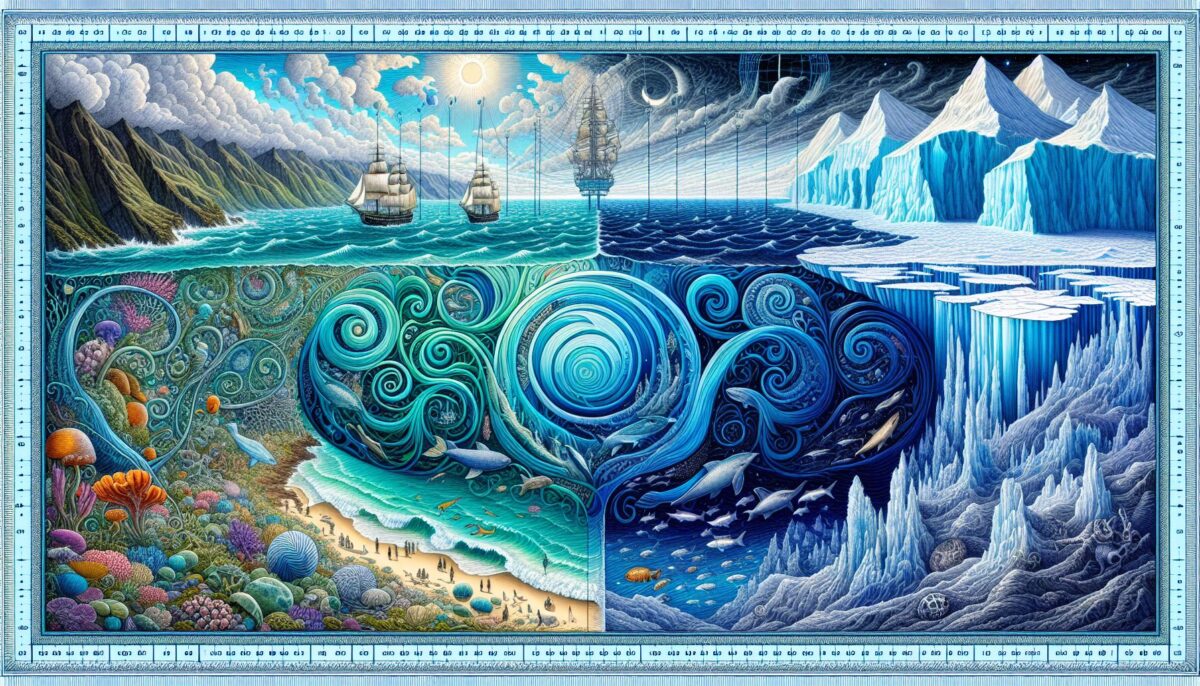Ocean currents are the continuous, massive movement of ocean water from one place to another. These currents shape our world’s weather patterns, maritime shipping routes, marine life diversity, and even the ever-emerging blue economy. In the grand panorama of ocean dynamics, ocean currents are the unseen symphonies wielding the baton of sea processes.
Unraveling the Tapestry of Ocean Currents
Just as wind scurries across the desert, unveiling invisible landscapes with each gust, so do ocean currents teeter through Earth’s oceans. The current can be cold or warm, surface or deep, hence creating a complex oceanography narrative.
Cold currents usually originate at the poles and move toward the equator, while warm currents begin in the tropics and progress towards the poles. As a rule of thumb, ocean currents in the Atlantic and Pacific oceans circulate in a clockwise direction in the northern hemisphere and counterclockwise in the southern hemisphere.
Surface Currents
Surface currents develop from friction between the ocean’s surface and wind. They constitute about 10% of all waters in the ocean and are typically the first 400 meters of ocean water. Notable examples include the Gulf Stream in the North Atlantic and the Kuroshio Current in the Pacific.
Deep Ocean Currents
Deep ocean currents, also known as thermohaline currents, make up the remaining 90% of the ocean. Unlike surface currents, these are primarily driven by changes in seawater density that occur due to variations in temperature (‘thermo’) and salinity (‘haline’).
Cradles of Climate: How Ocean Currents influence Global Weather Patterns
No conversation about global weather patterns would be complete without acknowledging the profound influence of ocean currents. They act as the conveyor belt for heat around the planet.
Warm surface currents like Florida’s Gulf Stream ferry substantial heat from the equator towards higher latitudes. When this warm water ultimately cools and sinks in areas around the Arctic, the result can be severe weather phenomena. This process can lead to the formation of powerful storm systems.
Moreover, the recent escalation in extreme weather events is potentially linked to changes in ocean currents. Scientists at the Potsdam Institute indicate that global warming weakens critical ocean currents, leading to severe weather alterations.
Ocean Currents and Marine Life
Ocean currents play a vital role in shaping the geographic distribution and diversity of marine life. Cold currents are nutrient-rich, attracting a wealth of marine biodiversity. Conversely, warm currents often lack nutrients, resulting in ‘marine deserts’ with sparse aquatic lifeforms.
A classic illustration is the Galápagos Marine Reserve. Home to an array of rich and diverse marine life, the sea’s prosperity is underpinned by the confluence of several oceanic currents, including the cold Cromwell and Humboldt currents.
Currents as commercial conundrums
Mariners have long recognized ocean currents as either boon or bane. For favorable directions, currents can shorten trips, conserve energy, and expedite deliveries. In contrast, currents can make navigation more dangerous and costly when they oppose a ship’s direction.
Ocean currents also dictate the locations of lucrative fishing spots. Nutrient-rich currents, for instance, are fishing hotspots with teeming schools of fish.
Ocean currents and the Blue Economy
An increasingly popular modern narrative is the concept of the blue economy – a sustainable economic model primarily focused on oceans. Ocean currents are being seen more and more as opportunities for tapping into renewable energy sources through tidal and wave energy generation.
Countries like the United Kingdom, Canada, and Australia are piloting projects that harness the energy of ocean currents. Similarly, the transport industry is intrigued by possible fuel cost reductions by strategizing shipping paths that align with favorable currents.
Conclusions and hopes on the horizon
As we learn more about our oceans, it is becoming abundantly clear that ocean currents play a formidable role in modulating marine biodiversity, our global climate, and commercial activities. The future of our marine environment, and perhaps our survival on this planet, hinges on the delicate dynamic of these unseen symphonies of the sea.
